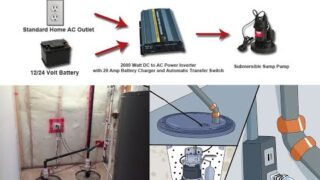Shop
We’ve compiled a list of the top-rated sump pumps available. Each currently has a rating of 4.7/5 or higher on Amazon. We will be adding more sump pumps after we do further research. Click on the product title link to learn more about each. In the sump pump description, you’ll find a video review of the product. Disclaimer: If you decide to purchase a product after clicking on the link, we do receive a small affiliate payment from Amazon. We appreciate your support and hope that you find our site helpful.
When buying a sump pump, consider the following 10 tips to ensure you make an informed decision:
- Determine your needs: Assess your specific requirements, such as the size of your basement, the average water flow, and any specific challenges you may face. This will help you choose a sump pump with the appropriate horsepower and capacity.
- Choose between pedestal and submersible pumps: Pedestal pumps have the motor located above the sump pit, making them easier to service but potentially noisier. Submersible pumps are submerged in the pit and are typically quieter but may require more effort for maintenance.
- Consider pump capacity: Look for a pump with a sufficient capacity (measured in GPH or gallons per hour) to handle the water volume in your basement. Consider factors such as rainfall intensity and the potential for heavy water flow.
- Check for durability: Opt for a sump pump made of durable materials like stainless steel, cast iron, or corrosion-resistant coatings. These materials ensure longevity and resistance to wear and tear.
- Look for efficient features: Features such as a top suction design to prevent clogging, float switches for automatic operation, and built-in alarms for alerts can enhance the efficiency and convenience of your sump pump.
- Consider power options: Determine whether you prefer a pump that operates on electricity or has a battery backup system. Battery backups can provide peace of mind during power outages, ensuring continuous protection against flooding.
- Research reputable brands: Look for well-known and reliable brands with a good reputation for producing high-quality sump pumps. Read customer reviews and ratings to gain insights into the performance and reliability of different models.
- Seek professional advice if necessary: If you’re unsure about the right sump pump for your specific situation, consider consulting with a professional plumber or a waterproofing specialist. They can offer personalized recommendations based on their expertise.
- Compare prices and warranties: Compare prices from different retailers and consider the value offered by each sump pump model. Additionally, pay attention to the warranty provided by the manufacturer to ensure you have coverage in case of any defects or malfunctions.
- Installation and maintenance: Familiarize yourself with the installation process and maintenance requirements of the sump pump you choose. Ensure you have the necessary tools and skills for installation, or hire a professional if needed. Regular maintenance is crucial to keep the pump in optimal condition and extend its lifespan.
Showing all 20 results
-

Superior Submersible Sump Pumps (12)
-

Zoeller Submersible Sump Pumps (8)
- Sale!

Superior Pump 92151 1 HP Cast Iron Sump Pump Side Discharge with Vertical Float Switch
$279.98 Shop Now! -

Superior Pump 92250 1/4-HP Thermoplastic Submersible Sump Pump with Tethered Float Switch
$66.78 Shop Now! -

Superior Pump 92330 1/3 HP Thermoplastic Submersible Sump Pump with Tethered Float Switch
$65.67 Shop Now! -

Superior Pump 92331 High-Capacity Cast Iron Sump Pump with Tethered Float Switch, 1/3 HP
$117.09 Shop Now! -

Superior Pump 92341 1/3 HP Cast Iron Submersible Sump Pump with Vertical Float Switch
$103.34 Shop Now! -

Superior Pump 92352 1/3 HP Cast Iron Submersible Sump Pump with Vertical Float Switch
$196.86 Shop Now! -

Superior Pump 92372 1/3 HP Thermoplastic Submersible Sump Pump with Vertical Float Switch
$107.84 Shop Now! - Sale!

Superior Pump 92511 1/2 HP Cast Iron Submersible Sump Pump with Vertical Float Switch
$176.10 Shop Now! -

Superior Pump 92541 1/2 HP Cast Iron Sump Pump with Vertical Switch
$103.34 Shop Now! -

Superior Pump 92570 1/2 HP Thermoplastic Submersible Sump Pump with Tethered Float Switch
$109.99 Shop Now! -

Superior Pump 92572 1/2 HP Thermoplastic Submersible Sump Pump with Vertical Float Switch
$119.99 Shop Now! -

Superior Pump Stainless Steel 92571 1/2 HP Cast Iron Sump Pump with Side Discharge Tethered Float Switch, Stainless
$151.17 Shop Now! -

Zoeller 105-0001 Sump Pump, 12.50 x 14.50 x 14.50 inches, 19 Pound
$307.00 Shop Now! -

Zoeller 264-0001 Sewage Pump, Black
$419.00 Shop Now! -

Zoeller 508-0006 Aquanot 508 ProPak53 Preassembled Sump Pump System with Battery Back-Up
$762.32 Shop Now! -

Zoeller 53-0002 N53 Mighty-Mate Non-Automatic Submersible Pump, 115V
$209.00 Shop Now! - Sale!

Zoeller 57-0001 M57 Basement High Capacity Sump Pump, 1 Pack, Stainless Steel
$237.33 Shop Now! - Sale!

Zoeller 98-0001 115-Volt 1/2 Horse Power Model M98 Flow-Mate Automatic Cast Iron Single Phase Submersible Sump/Effluent Pump …
$310.98 Shop Now! -

Zoeller M63 Premium Series 5 Year Warranty Mighty-Mate Submersible Sump Pump, 1/3 Hp
$305.00 Shop Now! - Sale!

Zoeller Waste-Mate 267-0001 Sewage Pump, 1/2 HP Automatic – Heavy-Duty Submersible Sewage, Effluent or Dewatering Pump
$417.40 Shop Now!














